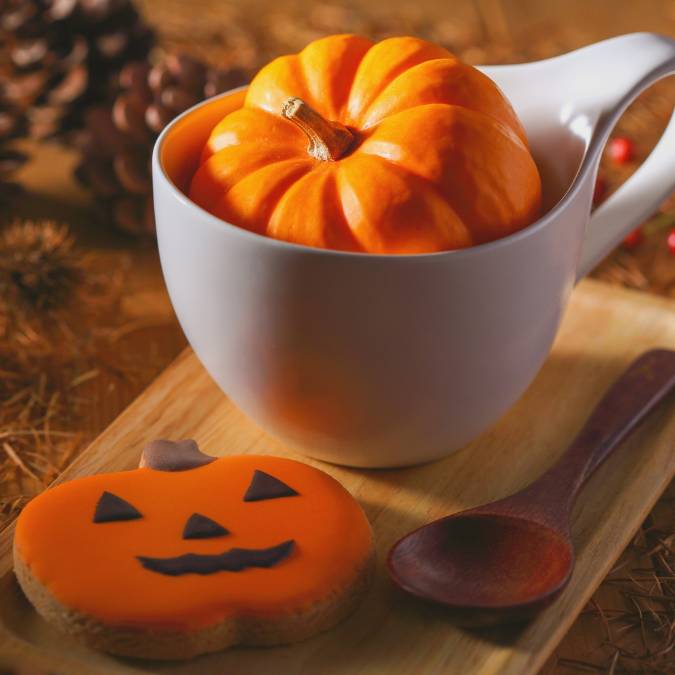
Exploring the ancient flavors of Samhain and All Hallows’ Eve through history and gastronomy
🎃 Before Trick-or-Treating, There Was the Feast
Today, Halloween is synonymous with candy, pumpkin spice, and chocolate bars. But centuries before children went door to door collecting sweets, this night was marked by hearty meals, ritual foods, and communal feasts meant to honor the dead and celebrate the harvest.
Long before commercial treats and neon costumes, Halloween was about nourishment — for both the living and the spirits who were believed to return from the other world.
In this article, we’ll travel back in time to rediscover the ancient culinary traditions behind Halloween, from the Celtic Samhain to All Hallows’ Eve in medieval Europe. You’ll learn how food played a spiritual role in rituals for the dead, and we’ll even revisit some historical recipes that you can still make today. 🍞🕯️
🌾 1. Samhain: The Celtic Festival of the Dead and the Harvest
Halloween’s true origins lie in Samhain (pronounced Sow-in), the Celtic festival celebrated over 2,000 years ago in Ireland, Scotland, and parts of northern France.
Samhain marked the end of the harvest season and the beginning of winter — a time when the Celts believed that the veil between the living and the dead grew thin. It was both a spiritual and agricultural turning point.
During Samhain:
- Families gathered to share seasonal foods like grains, root vegetables, and meats.
- People lit bonfires and prepared offerings to appease spirits.
- Feasts were held to honor ancestors, with empty seats left at the table for departed loved ones.
The food was simple but deeply symbolic — it represented the cycle of life and death, harvest and decay, light and darkness.
🥖 2. Food as a Bridge Between Worlds
For ancient peoples, food was more than sustenance — it was a sacred offering.
In Samhain rituals, it was common to prepare dishes both for the living and the dead. People would leave portions of their meals on doorsteps or near bonfires to feed wandering spirits. This act, known as “dumb supper” (silent supper), was meant to show respect for ancestors and invite their blessings.
In Ireland and Scotland, villagers believed that neglecting to feed the spirits could bring bad luck or poor harvests in the following year. Food was seen as a form of communication with the unseen world — a message of gratitude, remembrance, and hope.
🕯️ Typical offerings included:
- Oats and barley dishes, symbolizing fertility and abundance.
- Apples, sacred to the Celts as symbols of immortality.
- Turnips and root vegetables, which represented the earth and the harvest.
🍲 3. Ancient Dishes of Samhain: The Original Halloween Food
While we associate Halloween with candy today, the Celts enjoyed warm, comforting, and seasonal meals. Here are some of the most traditional dishes connected to Samhain and early Halloween customs.
🍞 Barmbrack (Ireland)
Barmbrack, or báirín breac, is a rich, fruit-filled bread that became a classic Halloween treat in Ireland. It’s made with dried fruits soaked in tea, spices, and yeast dough.
But barmbrack wasn’t just food — it was a fortune-telling ritual.
Before baking, symbolic objects were hidden in the dough:
- A ring predicted marriage 💍
- A coin promised wealth 💰
- A rag warned of financial troubles 🧵
- A stick suggested disputes or travel plans 🚶♂️
Each slice of barmbrack carried a mystery, and the family would gather eagerly to see what fate awaited them.
👉 Modern twist: You can still find barmbrack in Irish bakeries today during October, continuing a centuries-old Halloween tradition.
🥔 Colcannon (Ireland & Scotland)
Another beloved Halloween dish is colcannon, a hearty mash of potatoes, cabbage, and onions, often served with a generous dollop of butter.
Like barmbrack, colcannon also held a fortune-telling purpose. Rings or small coins were sometimes hidden inside, and whoever found them was said to be blessed with love or prosperity.
Colcannon was typically eaten during family gatherings on Halloween night, symbolizing comfort, unity, and abundance.
🥄 Historical note: Potatoes became a staple ingredient in Ireland only after the 16th century, but earlier versions of colcannon used parsnips or turnips — vegetables commonly available during Samhain.
🍎 Soul Cakes (England)
As Christianity spread across Europe, the Church sought to replace pagan customs with Christian observances. Samhain evolved into All Hallows’ Eve, the night before All Saints’ Day (November 1st) and All Souls’ Day (November 2nd).
During these days, families baked soul cakes — small round pastries flavored with nutmeg, ginger, cinnamon, and currants.
Children and the poor would go “souling,” visiting houses to sing prayers for the dead in exchange for these cakes.
This practice, known as “souling,” is considered a direct ancestor of trick-or-treating.
✨ Symbolism:
- The cakes represented charity and remembrance.
- Each cake eaten was said to release a soul from purgatory.
🥕 Samhain Stew and Root Vegetable Soup
Before candy and baked goods dominated the holiday, Samhain meals were rustic and earthy. Families prepared stews made from root vegetables, barley, and occasionally meat or game.
Ingredients were dictated by what was left from the harvest:
- Carrots 🥕
- Turnips
- Leeks
- Onions
- Barley or oats
These dishes symbolized the earth’s final gift before the long winter.
🔥 Fun fact: In many Celtic communities, families would save a small portion of their meal and throw it into the fire as an offering to protect their homes from wandering spirits.
🕯️ 4. Rituals and Food for the Dead
The idea of feeding the dead through ritual has survived across centuries and cultures.
In medieval Europe, the “dumb supper” tradition continued, especially in rural Ireland and Scotland. Families would set a table for the spirits, eating in silence to invite the presence of their ancestors.
In some regions, the first spoonful or slice of food was placed outside or by the fireplace as an offering.
Similar customs appear around the world:
- In Mexico’s Día de Muertos, families prepare pan de muerto and favorite dishes of their loved ones.
- In Eastern Europe, people bake special breads to honor souls visiting during All Saints’ Eve.
- In Italy, fave dei morti (beans of the dead) — almond biscuits — are still baked for the occasion.
Halloween, then, was never just about fear — it was about connection. Through food, people remembered their dead, gave thanks for life, and hoped for blessings in the year ahead.
🕸️ 5. Forgotten Recipes You Can Still Cook Today 👩🍳
Want to bring some ancient Halloween flavor to your table? Here are a few historical recipes adapted for the modern kitchen — simple, authentic, and rich in tradition.
🍞 Traditional Irish Barmbrack
Ingredients:
- 2 cups of strong black tea (cold)
- 1 cup mixed dried fruit
- 2 cups self-raising flour
- 1 egg
- 1 tsp mixed spice
- ½ cup brown sugar
Instructions:
- Soak the fruit overnight in tea.
- Mix all dry ingredients in a bowl.
- Add egg and fruit mixture.
- Pour into a greased loaf pan.
- Bake at 170°C (340°F) for about 1 hour.
🥧 Add a small ring or coin wrapped in parchment for the traditional twist!
🥔 Classic Colcannon
Ingredients:
- 4 large potatoes
- ½ head of green cabbage
- 1 onion
- Butter, salt, and pepper to taste
Instructions:
- Boil potatoes until tender.
- In a pan, cook chopped onion and cabbage until soft.
- Mash everything together with butter, salt, and pepper.
Optional: Hide a coin inside for fun fortune-telling!
🍪 Soul Cakes
Ingredients:
- 2 cups flour
- ½ cup butter
- ½ cup sugar
- 1 tsp mixed spice
- 1 egg
- 2 tbsp milk
- A handful of currants or raisins
Instructions:
- Preheat oven to 180°C (350°F).
- Mix butter and sugar until creamy.
- Add egg, milk, and spices.
- Stir in flour and currants.
- Shape into small rounds and bake for 15 minutes.
These are soft, lightly spiced, and perfect with tea — a sweet reminder of medieval All Hallows’ Eve. ☕
🌙 6. From Ritual Meals to Candy Bags
The transformation from ritual meals to modern trick-or-treating began in the 19th century, when Irish and Scottish immigrants brought their traditions to North America.
In the U.S., the older customs of souling and guising (dressing up to earn food) gradually merged with the American love for candy and celebration.
By the mid-20th century, with the rise of mass production and advertising, candy companies replaced ancient breads and stews with chocolates and sweets.
Yet, beneath all the commercial glitter, Halloween still carries echoes of those ancient harvest feasts and ritual offerings — moments when food symbolized remembrance, gratitude, and connection to the past.
🎃 Conclusion: The Forgotten Feast Behind the Fright
Before the plastic pumpkins and candy wrappers, Halloween was a meal — a night of warm bread, spiced cakes, and simple, shared dishes.
Through food, people honored their dead, celebrated the harvest, and marked the turning of the seasons.
Revisiting these ancient recipes isn’t just nostalgic — it’s a way to reconnect with the true spirit of Halloween: a time for remembrance, gratitude, and community.
So this year, before reaching for the candy bowl, why not bake a loaf of barmbrack, mash a bowl of colcannon, or share a few soul cakes with loved ones?
Because the sweetest part of Halloween has always been the feast itself. 🍞🕯️
Sources:
- National Museum of Ireland – “Samhain: Food, Ritual and Tradition”
- BBC History – “The Real Origins of Halloween”
- Smithsonian Magazine – “Soul Cakes and the Birth of Trick-or-Treating”
- Historic UK – “Barmbrack: Ireland’s Fortune-Telling Bread”
- Irish Central – “Ancient Halloween Recipes and the Celtic Feast of Samhain”

